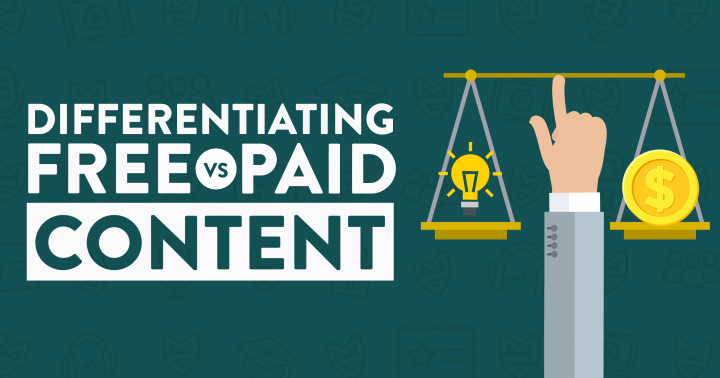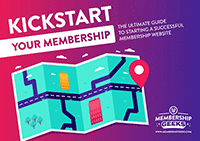Memberships come in all shapes and sizes but the majority that we work with follow content and community models.
Couple this with the fact that content marketing is, in our opinion, the most effective marketing strategy for memberships, and you find yourself in a tricky situation.
If it’s all content, where do you draw the line between free (used as part of your marketing strategy) and paid (kept inside your membership)?
I recently did a Facebook Live where I gave 2 broad “rules” of thumb to help you differentiate between free and paid content:
- Give away the what and why; sell the how
- Differentiate by depth & scope
Check out the video for a primer on these approaches:
https://www.facebook.com/218555618305440/videos/770814450113042/
However diving deeper into deciding which pieces of your content should be free and which should be paid means making difficult decisions – some of which might feel arbitrary – but there are five questions you can ask yourself to bring some sense to the situation.
What separates free content and paid content?
The line between free content and paid content is always moving – and deciding whether you’ve written a really good blog post or written part of your next great membership course isn’t always obvious, but there are some easier-to-spot signals of free and paid content.
- A 5 minute podcast is prime free content. A 5 hour course is undoubtedly membership content
- Shorter content generally means less detailed content. This usually means you’re giving broader coverage of a solution, rather than detailed steps for execution, or drilling down into the detail of one specific part of a solution
- Your free content will usually cover the “what” and “why” of a solution, but it will hold back from explaining the “how”
- Paid content is not only more in depth but can also be tailored to a specific subsection of your audience (or even individually tailored – Q&As or a specific piece of coaching)
The power of convenience
When it comes to your membership, it’s not just a question of the value you provide but the convenience as well.
Think of your blog posts, videos, and podcast episodes as pages of a book.
If you told somebody they had to wander around a library and collect pages one-by-one, returning them, and then finding the next… You’re going to have a hard time convincing them it’s worth it.
If you were to provide them with the pages all together, that convenience is very valuable.
Even if your paid content isn’t necessarily hugely different to your free content, you shouldn’t underestimate the value of offering convenience.
People pay to make things easier in their lives. Memberships do exactly that.
Five questions to determine whether your content should be free or paid
If your content hasn’t easily divided itself up into free or paid categories (how rude of it!), then there are five questions you can ask yourself to make this difficult process a lot easier:
1) What problem does this piece of content solve?
Take a closer look at the content you’ve created and analyze the problem it’s actually solving for your audience.
How does your content relate to the main problem your target market has?
If your content touches on a sort-of-related-but-not-really topic, you don’t need to hold onto it quite as tightly.
If it’s a key part of how your audience solve the problem your membership focuses on, then keep it inside your membership.
2) How big is the problem your content is solving and how important is it to your audience?
If you are providing a solution that will double the household income of one of your readers… that’s worth far more to them than if you’re solving how to save $5 on their next trip to the grocery store.
Think about the impact your content could have on your readers, if it’d leave them jumping for joy, lightbulbs over their heads, and making their year… It’s worth keeping that as paid content!
3) How comprehensive is the solution you’re providing?
If we stick with the above example of doubling a household’s income, that’s a hugely valuable solution you would be providing and it would cover a host of different details.
If your content is “7 tips to help you increase your income this year” and it’s 800 words… Realistically, that isn’t going to solve their problem in the same way.
The level of comprehensiveness determines how much value your content provides and is a solid determining factor if you’re choosing whether it should be free or paid.
4) Is there any level of exclusivity to what you have created?
If you have written the only guide to a specific technique, if it’s something that isn’t available anywhere else from anyone else, if it’s something that’s completely unique, there can be no doubt that it is worth monetizing.
The specificity, rarity, and expertise of your content is a vital consideration if you aren’t sure if it should be free or inside your membership.
5) How tailored is this content?
Have you created something that’s really relevant to a small subsection of your audience? If so, it’s likely to be worth monetizing.
If your content is more generic – broadly appealing to most of your potential audience – then it’s less valuable as paid content.
It’s the difference between “8 ways software developers can double their income in 3 years” and “How to ask your boss for a raise – and get it”.
The true value of your membership
Remember that, as a membership site owner, you’re not selling content… You’re selling solutions to a problem.
That solution may involve content, courses, eBooks, videos, or similar, but those are only conduits to you solving a problem.
People aren’t joining your membership for your content.
They’re joining for the amazing community, for the access to you and your expertise, and for the opportunity to be surrounded by like-minded people who support them and keep them accountable.
Always keep this in mind: nobody joins a membership to stand still, and people don't just just for the “stuff”.
Understanding this is key to being able to craft an effective membership content strategy and to being able to balance between free and paid content.






